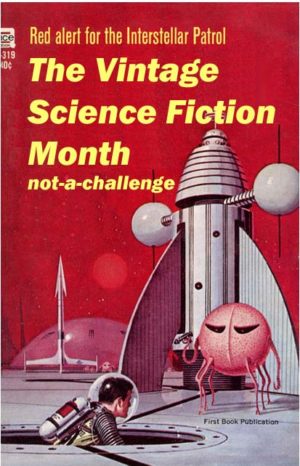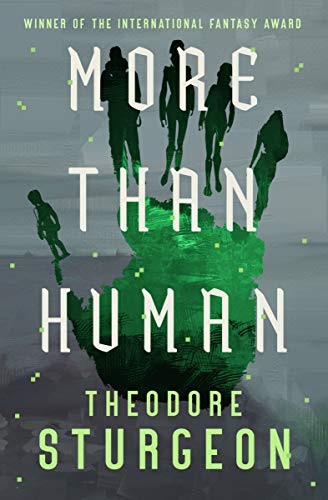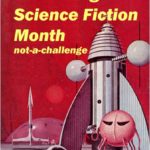Continuing on my list for Vintage Science Fiction Month, I read Theodore Sturgeon’s 1953 novel, More Than Human. This was my introduction to Sturgeon’s work, and I’m in awe of his accomplishment. From the beginning, it’s clear you’re in the hands of a master. Forget genre, this is just great fiction writing. More Than Human is a riveting story told through three interwoven novellas, “The Fabulous Idiot”, “Baby is Three” (this was the first written) and “Morality”.
Together these three segments describe different phases of the emergence of a new life form, Homo Gestalt. This consists of a group of humans with extraordinary powers: a strange “baby” who is the brain, a strong man whose limited mind comes to include extraordinary powers when linked to the “brain”, teleporting twins who can retrieve anything the group needs to survive, and a young girl capable of telekinesis who is the vital link to the brain and who communicates baby’s insights and instructions to the others.
I love all sorts of stories about collective minds, but More Than Human is one of the few in which all members of the group have equally necessary roles. They are like parts of a single body, yet, as it emerges in the third section (and that makes you look back closely over the first two) they lack a critical part of their functioning, a conscience.
But I can’t summarize the elements of the story without pointing to some destructively dated language. Much as I admire the beauty and power of Sturgeon’s writing I can’t ignore the use of “colored people”, “Negroes” and the N-word, even though these are mostly used by pretty monstrous characters you have to hate. Sturgeon’s narrative is in many ways a repudiation of these prejudices, and for his time that was definitely a good thing. But still the language grates and offends.
So does the peculiar position of women characters. Yes, several of them have insight and in some cases extraordinary powers, but they mostly serve to support men and help them recover so they can set the world right.
If you can grant a man of the 1950s a pass for being “of his time” you can enjoy the marvelous power of the ideas in More Than Human and Sturgeon’s ability to fuse them into his characters so that they really drive the story.
The novel gradually unfolds the story of the emergence of Homo Gestalt by focusing first on a man named Lone. He starts off mysteriously with mostly an animal consciousness. He has no ability to speak because words have not been necessary – he feels and acts upon the sense that words convey. Then one day, as he is going about his life of bare survival in the woods, he feels a call from another being.
It was a sending straight to what was human in him, received by an instrument which, up to now, had accepted only the incomprehensible radiations of the new-born, and so had been ignored. But now it spoke, as it were, in his own tongue. … His mouth opened and a scratching sound emerged. He had never tried to speak before and could not now; the gesture was an end, not a means, like the starting of tears at a crescendo of music.
More Than Human, Kindle edition, Locations 130 and 141
What he senses is the longing of a young woman named Evelyn who has been confined with her sister, Alicia, to a home surrounded by a massive iron fence. They are under the control of a vicious father determined to cut them off from the rest of the world and their own humanity. As in a fairy tale, Lone uses his incredible strength to break through the fence and make contact with Evelyn, but the father appears, beats Lone nearly to death, kills Evelyn and then himself.
When Lone revives enough to move, he encounters a humble farming couple, the Prodds, who take him in and nurse him back to health. He learns a lot from them, including how to speak, but ultimately he has to leave when they have a child. That baby, however, turns out to be too strange for the Prodds to handle. Lone takes him in, along with a brash young girl named Janie, who can makes objects move with the power of her mind, and two young girls who can teleport themselves. Together this group is the beginning of Homo Gestalt.
As they spend years together they mature to the point where Lone, taking in knowledge from Baby through Janie’s interpretation of the strange infant’s thoughts, can read people’s minds by looking into their eyes. One day, Lone demands to know what this group adds up to and Janie interprets Baby’s thinking: “He says he is a figure-outer brain and I am a body and the twins are arms and legs and you are the head. He says the ‘I’ is all of us.” So this new form of human has emerged.
The second section introduces a new character, the 15 year-old Gerry, who is trying to reconstruct the memories of his life after a traumatic event. He does this through his sessions with a psychiatrist whom he has sought out. It turns out that Gerry is a master manipulator, but his gradual revelations of his past are extremely powerful. He realizes that from the age of eight onward he has been part of the gestalt life-form after being taken in by Lone and the others. He tries to explain this to the psychiatrist and the phenomenon called “bleshing” which is the integration of all the separate people into one organism.
“This all happens with humans,” he said eventually. “It happens piece by piece right under folks’ noses, and they don’t see it. You got mind-readers. You got people can move things with their mind. You got people can move themselves with their mind. You got people can figure anything out if you just think to ask them. … What you ain’t got is the one kind of person who can pull ’em all together, like a brain pulls together the parts that press and pull and feel heat and walk and think and all the other things. “I’m one,” he finished suddenly.
More Than Human, Kindle edition, Location 2044-46
I can’t go into more detail without revealing the whole story, but the third section introduces a third character, Hip Barrows, who provides another critical link to complete the gestalt. He is rescued by Janie, now a grown woman, from confinement because of his obsessive and destructive behavior. Janie works hard to coax him to find out what has led to his strange condition, much as the psychiatrist helped Gerry, but in much more human terms.
This all leads to a powerful confrontation between Gerry and Hip that completes the formation of the more than human group being. OK, the ending and resolution aren’t nearly as convincing as the rest of the story, but they make perfect sense. Moreover, they forced me to go back over the rest of the book to see how well all its parts fit together. And I just love Sturgeon’s writing, nothing wasted, poetic when it has to be, tough and driving when the story calls for it.
Everything is worked out through the traumatic and powerful experiences of the characters. Sturgeon was a great artist, someone whose retroactively judged lapses of dated language and ideas cannot cancel the rest of his achievement. I look forward to digging into the rest of his work.






Leave a Reply